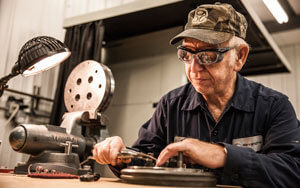If everything you try works, you are not trying enough ideas.
Naturally, we are inclined to talk about our success stories, rather than our failures. But it can be in our failures where we discover the next great idea.
Searching for opportunities to make process improvements is at the heart of what we do at Alexandria Industries. Whether we recommend a new alloy for ease of extrudability, or we tweak the way we machine a component, our intention with proposing a new idea is to generate a greater return on your investment. Sometimes, however, this is not the case, and a new idea may sink faster than a rock that didn’t skip. Either way, we continuously strive to find new ways to make your great products even better.
Changes do not always work
For years, we used an extrusion die to manufacture a long lineal aluminum extrusion for one of our marine customers. The die created a component that was easy and quick to assemble at the customer’s site.
The challenge was in the extrusion process. The product’s design required that the die’s profile include a single, stand-alone tongue. With the extreme amount of force, or pressure, put on the die by pushing heated aluminum through it during the extrusion process, the die’s tongue would break off. This required us to order a new die, which we often did.

Alexandria Industries’ in-house die shop works closely with customers to ensure their dies are properly prepared for the aluminum extrusion process.
To solve the problem, we needed to work with our customer to find a
way to make the product using a die design that could better withstand the force of extruding aluminum. The trouble with redesigning a new die profile to make it more successful during the extrusion process meant the customer’s component design also would need to change. The new design would need to both increase the die’s life, while meeting the customer’s product design specifications.
Although the new die design worked excellent for the extrusion process, it posed some unanticipated assembly challenges for our customer. This was not acceptable to Alexandria Industries, or our customer.
Back to the drawing board we went.
While the first die redesign did not fit the customer’s needs, our team is determined to find a solution that will help make the components easier to manufacture, while keeping replacement tooling costs within a normal range.
Making It Manufacturable
We strive to make the products our customers need in a way that is manufacturable, and cost-effective for us as a business. Even though the new die design we created did not work, we learned new things by going through the redesign process. The experience gave us the opportunity to learn new ways to design an existing component and work toward creating the next big idea.
When we work on a new profile for an existing part, we become more familiar with the part’s functionality and the context in which it is used. In this case, we now fully understand the component’s essential functions, and the way it mates with other parts of the entire product assembly. We learned from what didn’t work.
We are not a “once we fail, we are done” organization. Failing in our first attempt to find a resolution, only drives us more toward finding a creative solution that will work. Today, we are creating another new design we hope will work for the customer and for us. Being able to determine the best design and manufacturing processes to get us to a final shape will make the biggest impact on manufacturability and cost.
We gauge a successful product development process by getting customers what they need in the shortest time possible, and for the lowest cost. Not every story we have to share, however, is a success story. We see the value in continuous improvement. By looking at what we learned from our trials and errors, we have the opportunity to create a great idea that does work.
